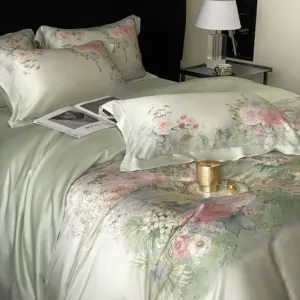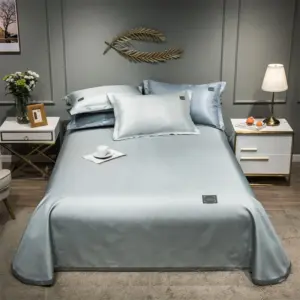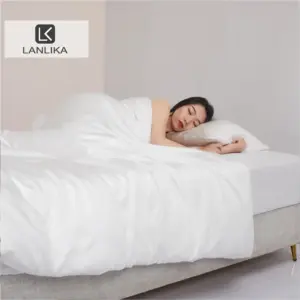Understanding Hypoallergenic Properties and Silk’s Unique Position
When we talk about hypoallergenic textiles, we’re referring to materials that are less likely to cause allergic reactions. While no fabric can claim to be 100% allergen-free, some materials naturally possess properties that make them exceptionally gentle on sensitive skin. Among these, silk stands apart as nature’s premier hypoallergenic fabric.
For thousands of years, silk has been treasured not just for its luxurious feel, but also for its remarkable skin-friendly qualities. Even in ancient times, silk was used for medical applications, with physicians recognizing its unique ability to minimize skin irritation and promote healing. This wasn’t just ancient wisdom – modern science has uncovered the multiple factors that contribute to silk’s exceptional hypoallergenic nature.
What makes silk truly special is that its hypoallergenic properties aren’t the result of chemical treatments or manufacturing processes – they’re inherent to the fabric itself. From its unique protein structure to its physical characteristics, silk offers a naturally gentle option for those with sensitive skin.
Understanding the hypoallergenic properties of silk fabric can be particularly valuable for anyone suffering from allergies, skin sensitivities, or simply seeking the purest sleep environment possible. Throughout this article, we’ll explore the scientific reasons behind silk’s gentle nature, examining everything from its molecular composition to its practical benefits for various skin conditions.
The Protein Composition of Silk: Nature’s Hypoallergenic Formula
At the molecular level, silk’s hypoallergenic magic begins with its unique protein structure. Unlike many other natural and synthetic fabrics, silk is composed primarily of two proteins: fibroin and sericin. These proteins are fundamentally different from the proteins that commonly trigger allergic reactions in humans.
The Role of Fibroin
Fibroin makes up the core of silk fibers and consists mainly of the amino acids glycine and alanine arranged in a highly regular, repeating pattern. This molecular arrangement creates a stable, crystalline structure that contributes to silk’s remarkable strength and smoothness. The simplicity and regularity of fibroin’s structure mean it contains few of the complex protein sequences that our immune systems typically react to.
Sericin’s Natural Protection
In its natural state, silk contains a protein called sericin that coats the fibroin core. Sericin has natural antibacterial properties that help protect the silkworm cocoon in nature. During quality silk processing, most of the sericin is gently removed while preserving the beneficial properties of the fibroin core. This careful processing ensures that quality silk maintains its hypoallergenic characteristics without retaining potential irritants.
Chemical Neutrality
Another significant factor in silk’s hypoallergenic nature is its remarkable chemical neutrality. Silk has a pH level very close to that of human skin, making it inherently compatible with our body’s natural chemistry. Unlike many synthetic fabrics that can contain residual chemicals from manufacturing processes, high-quality silk is notably free from irritating compounds that might trigger sensitive skin.
The molecular structure of silk creates an incredibly smooth surface at the microscopic level. This smoothness means there are fewer rough edges or protrusions that could irritate the skin, making silk particularly beneficial for those with natural silk properties for sensitive skin. The combination of these protein characteristics creates a fabric that is uniquely gentle on human skin at the most fundamental level.
The Physical Structure: Why Allergens Can’t Hide in Silk
Beyond its chemical composition, silk’s physical structure plays a crucial role in its hypoallergenic properties. When compared to other fabrics, silk’s unique construction offers several advantages that help keep allergens at bay.
Long, Continuous Fibers
One of silk’s most distinctive features is its incredibly long, continuous fibers. While cotton fibers typically measure just a few centimeters in length, a single silk fiber can stretch unbroken for hundreds of meters. This continuous structure creates fewer ends and gaps where allergens could potentially lodge.
The remarkable length of silk fibers allows them to be woven into exceptionally tight, smooth fabrics. This density creates a natural barrier against common allergens like dust mites, pollen, and dander, preventing them from penetrating deep into the material.
Smooth Surface Texture
At the microscopic level, silk fibers have an incredibly smooth surface compared to other natural fibers:
- Cotton fibers have a rough, irregular surface with many crevices
- Wool fibers feature overlapping scales and irregular texture
- Silk fibers present a smooth, uniform surface with minimal irregularities
This smoothness means there are fewer places for irritants and allergens to become trapped. The silky-smooth surface minimizes friction against the skin, reducing the physical irritation that can trigger sensitivity reactions.
Weave Density and Quality
The quality of silk is often measured in momme weight, with premium silk typically falling in the 19-25 momme range. This measurement reflects the density of the silk weave, with higher momme counts indicating tighter weaves that create a more effective barrier against allergens. Understanding the significance of momme weight and silk quality helps consumers choose silk products with optimal hypoallergenic properties.
The tight weave of quality silk creates a physical barrier that prevents allergens from penetrating the fabric. When combined with silk’s smooth fiber structure, this creates an environment where allergens simply have nowhere to hide – they can’t easily embed themselves within the fabric or cling to the surface, making silk naturally resistant to common irritants.
Moisture Management: Creating an Inhospitable Environment for Allergens
One of silk’s most remarkable properties is its exceptional ability to manage moisture – a characteristic that directly contributes to its hypoallergenic nature. Unlike many other fabrics, silk can absorb up to 30% of its weight in moisture without feeling wet to the touch.
This impressive moisture management creates an environment that’s naturally inhospitable to many common allergens. Dust mites, for example, thrive in warm, humid environments – precisely the conditions that silk helps prevent through its moisture-wicking properties.
Comparison of Moisture Properties Among Common Fabrics
| Property | Silk | Cotton | Polyester |
|---|---|---|---|
| Moisture absorption | Up to 30% of weight | Up to 25% of weight | Less than 1% |
| Drying time | Fast | Slow | Very fast |
| Feel when damp | Remains dry to touch | Feels wet | Feels clammy |
| Breathability | Excellent | Good | Poor |
Silk achieves this perfect balance through its unique fiber structure. The protein molecules in silk fibers contain side chains that can bind water molecules, drawing moisture away from the skin. However, unlike cotton which tends to hold onto moisture, silk efficiently releases that moisture into the air through evaporation.
This moisture regulation creates several hypoallergenic benefits:
- Prevents the humid conditions that dust mites need to thrive
- Discourages mold and mildew growth that can trigger allergies
- Maintains a dry surface that doesn’t promote bacterial proliferation
- Regulates temperature to prevent sweating, which can exacerbate skin sensitivities
These moisture management properties make silk especially valuable for hypoallergenic bedding options, as they help maintain an optimal sleep environment throughout the night. By keeping moisture levels balanced, silk naturally creates conditions that are unfriendly to many common allergens.
Natural Resistance to Common Allergens
Silk’s unique physical and chemical properties come together to create remarkable resistance to various common allergens. This natural defense makes silk particularly valuable for those with sensitivities and allergies.
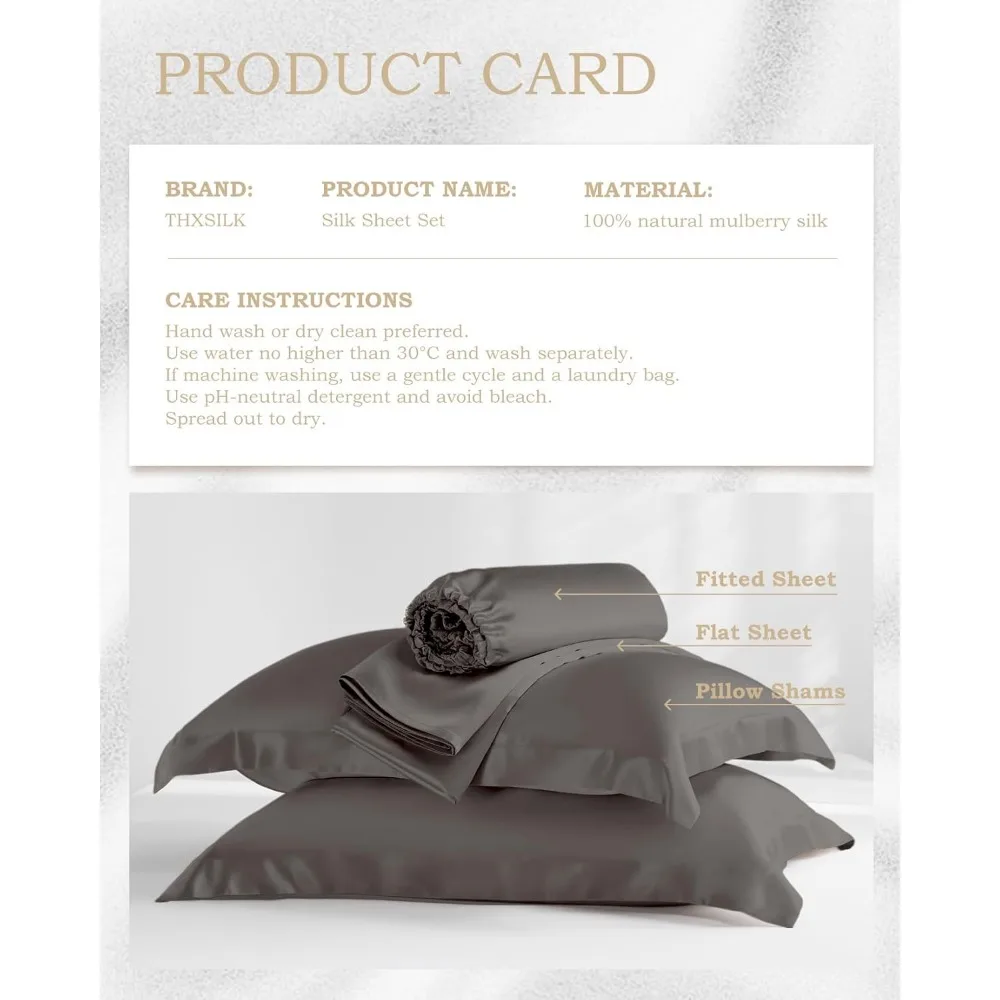
Dust Mites
Dust mites are microscopic creatures that feed on skin cells and thrive in warm, humid environments – particularly in bedding. These tiny pests are one of the most common triggers for allergic reactions and respiratory issues. Silk naturally deters dust mites in several ways:
- The tight weave of silk creates few spaces for dust mites to inhabit
- Silk’s moisture-wicking properties create a drier environment that’s inhospitable to mites
- The smooth fiber structure provides fewer places for mites to attach and colonize
For this reason, silk bedding for allergy sufferers can provide significant relief from dust mite allergies without requiring chemical treatments.
Mold and Mildew
Silk’s exceptional moisture management doesn’t just help with dust mites – it also creates an environment that’s naturally resistant to mold and mildew growth. By efficiently wicking away moisture and allowing it to evaporate, silk stays drier than many other fabrics, preventing the damp conditions that fungi need to thrive.
Pet Dander and Environmental Allergens
Many people suffer from allergies to pet dander, pollen, and other airborne particulates. Silk’s tight weave and smooth fiber structure offer natural advantages here as well:
- Silk has minimal static electricity compared to synthetic fabrics, attracting fewer airborne particles
- The smooth fiber surface makes it difficult for dander and pollen to embed deeply into the fabric
- Allergens that do land on silk can be more easily removed due to the smooth surface
Premium Mulberry silk sheets offer these protective qualities while also providing exceptional comfort, making them ideal for creating a low-allergen sleep sanctuary.
Environmental Pollutants
Modern environments contain numerous potential irritants, from pollution particles to chemical residues. Silk’s natural properties help minimize exposure to these irritants:
- The tight weave acts as a natural filter against particulate matter
- The smooth surface repels rather than attracts many airborne particles
- Silk requires fewer chemical treatments in processing compared to many other fabrics
This multi-layered defense against common allergens makes silk a naturally protective barrier for those with sensitivities.
Silk’s Benefits for Sensitive Skin Conditions
Beyond its ability to repel external allergens, silk offers direct benefits for various skin conditions due to its gentle interaction with the skin’s surface.
Eczema and Atopic Dermatitis
For those suffering from eczema and atopic dermatitis, silk provides several specific benefits:
- Minimal friction reduces the mechanical irritation that can trigger flare-ups
- Moisture regulation helps maintain optimal skin hydration
- The smooth surface prevents the “catching” on rough skin patches that can cause pain
- Temperature regulation reduces overheating that can exacerbate itching
Rosacea and Facial Sensitivity
The face is particularly vulnerable to fabric irritation during sleep. Silk offers special advantages for those with rosacea or sensitive facial skin:
- Reduced friction means less irritation of delicate facial skin
- The smooth surface minimizes “sleep creases” that can aggravate sensitive skin
- Natural cooling properties help reduce the flushing associated with rosacea
- Silk allows facial skin to glide across the surface without catching or pulling
The hypoallergenic features of silk sheets and silk pillowcases make them particularly valuable for protecting facial skin during sleep.
Psoriasis and Contact Dermatitis
Those with psoriasis or contact dermatitis often experience heightened sensitivity to fabric textures and chemicals:
- Silk’s natural proteins are less likely to trigger reactions than synthetic materials
- The smooth texture doesn’t aggravate raised or inflamed skin areas
- The breathable nature of silk prevents the trapped heat that can worsen symptoms
- Silk requires fewer chemical treatments than many other fabrics
Many dermatologists recommend silk for patients with sensitive skin conditions precisely because it combines these beneficial properties without introducing potential irritants.
Mulberry Silk: The Gold Standard for Hypoallergenic Quality
While various types of silk exist, Mulberry silk stands as the gold standard for hypoallergenic properties and overall quality. This premium silk comes specifically from Bombyx mori silkworms that feed exclusively on mulberry leaves, resulting in exceptionally pure fibers.
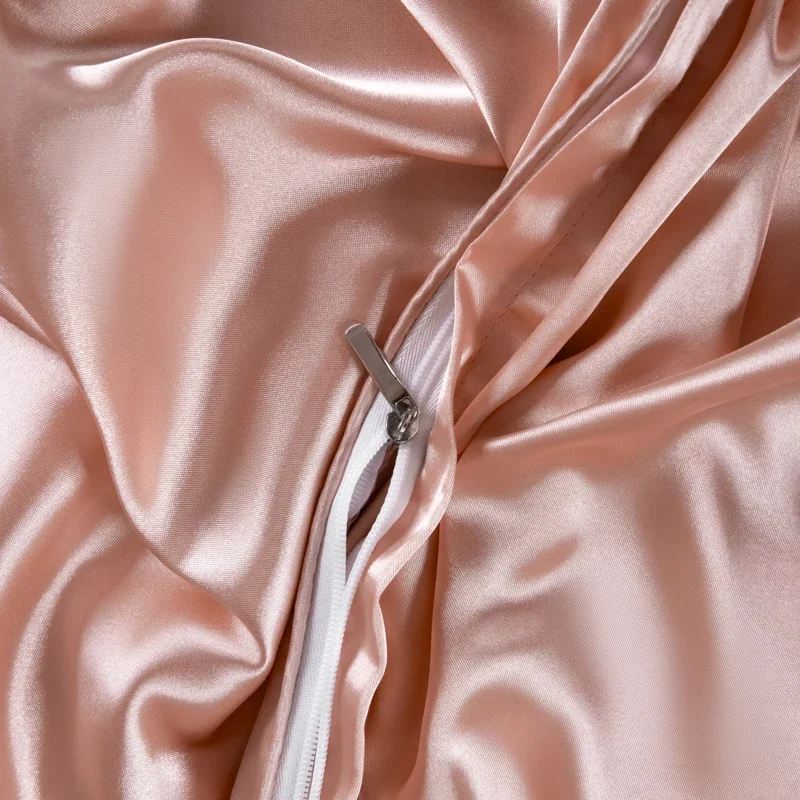
Quality Indicators in Hypoallergenic Silk
When seeking truly hypoallergenic silk, several quality factors become important:
Momme Weight: Premium silk in the 19-25 momme range provides the ideal balance between durability and softness. This optimal density creates an effective barrier against allergens while maintaining silk’s breathable nature.
Processing Methods: High-quality silk processing preserves the natural benefits while minimizing potential irritants. The best silk undergoes gentle degumming processes that remove sericin (which can cause reactions in some people) without harsh chemicals.
Pure Composition: True hypoallergenic silk should be 100% Mulberry silk without blended materials that might introduce potential allergens or reduce beneficial properties.
Certifications: Look for OEKO-TEX or similar certifications that verify the absence of harmful substances and proper processing methods.
Understanding the best types of silk for bedding helps consumers make informed choices for their specific needs. Premium Mulberry silk bedding sets offer the most comprehensive hypoallergenic benefits, combining optimal fiber quality with proper manufacturing processes.
The superior quality of Mulberry silk doesn’t just provide better comfort – it directly enhances the hypoallergenic properties by ensuring maximum purity, optimal fiber structure, and minimal introduction of potential irritants during production. This makes it particularly valuable for those with significant sensitivities.
Comparing Silk to Other “Hypoallergenic” Fabrics
While many fabrics claim hypoallergenic properties, they differ significantly in how they achieve these benefits and how effective they truly are. Understanding these differences helps consumers make informed choices based on their specific needs.
Silk vs. Cotton
Cotton is often marketed as a natural, breathable option, but it differs significantly from silk in several key areas:
- Fiber Structure: Cotton has short, rough fibers with many ends and crevices where allergens can hide, while silk has long, smooth continuous fibers.
- Moisture Management: Cotton absorbs moisture but retains it, creating potential breeding grounds for dust mites and mold. Silk absorbs moisture but efficiently releases it through evaporation.
- Dust Mite Resistance: Cotton provides an ideal environment for dust mites due to its structure and moisture retention, while silk naturally deters dust mite colonization.
- Skin Interaction: Cotton can catch on rough skin patches and cause friction, while silk glides smoothly over the skin surface.
Silk vs. Synthetic “Hypoallergenic” Materials
Many synthetic fabrics claim hypoallergenic properties through chemical treatments rather than natural characteristics:
- Chemical Processing: Synthetic fabrics often require chemical treatments to achieve hypoallergenic properties, which can ironically cause reactions in chemically sensitive individuals. Silk is naturally hypoallergenic without added treatments.
- Breathability: Most synthetics trap heat and moisture against the skin, while silk provides natural temperature regulation.
- Electrostatic Properties: Synthetic fabrics often generate static electricity that attracts dust and allergens. Silk has minimal static cling.
- Longevity of Properties: Chemical treatments on synthetics can wash out over time, reducing their hypoallergenic effectiveness. Silk’s properties are inherent to the fiber itself.
Understanding natural hypoallergenic fabrics and how they compare to synthetic options provides valuable context for those seeking truly skin-friendly materials. While different fabrics may be suitable for different needs, silk consistently emerges as the most hypoallergenic fabric due to its comprehensive natural properties rather than added treatments or coatings.
Maintaining Silk’s Hypoallergenic Properties
To fully benefit from silk’s hypoallergenic properties over time, proper care is essential. The right maintenance practices preserve silk’s beneficial qualities while preventing the introduction of potential irritants.
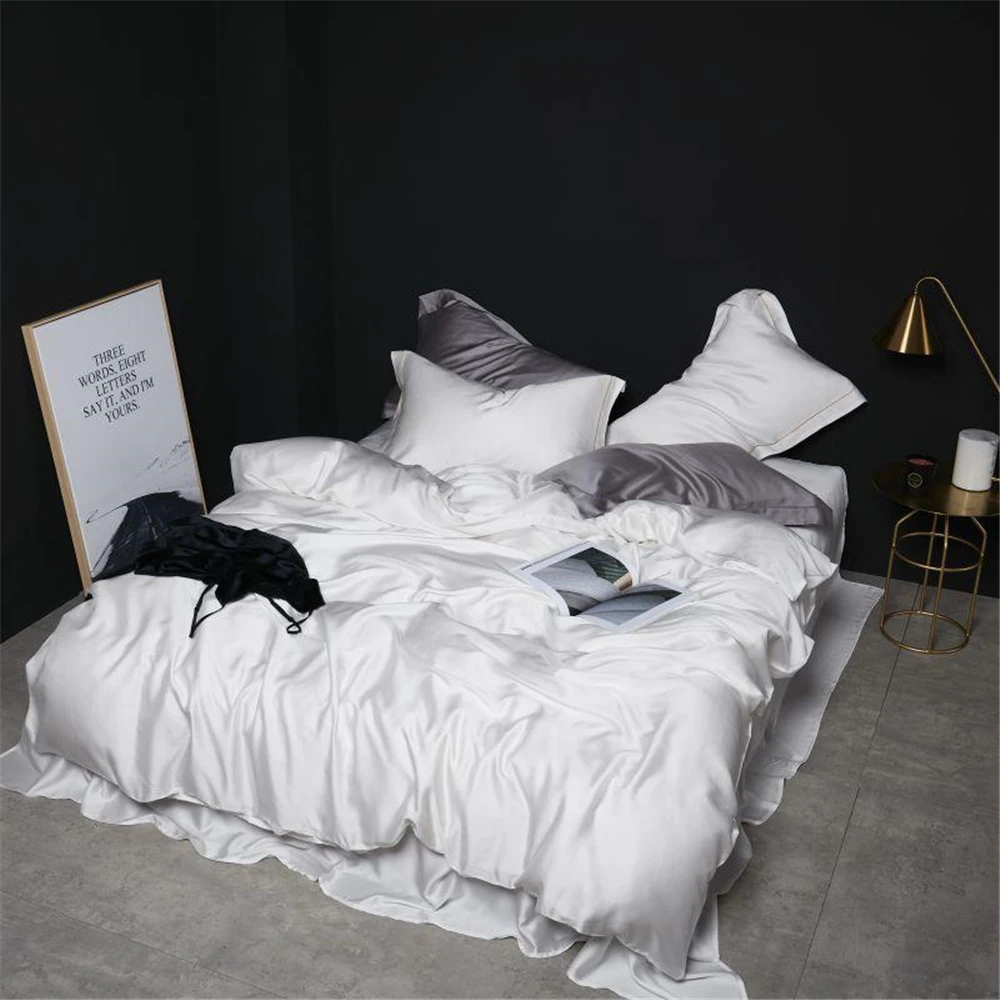
Gentle Washing Techniques
- Use mild, pH-neutral detergents specifically formulated for silk
- Wash in cool water (30°C/86°F or cooler) to preserve protein structure
- Hand wash or use the delicate cycle on your washing machine
- Avoid bleach, fabric softeners, and enzymes that can damage silk proteins
- Rinse thoroughly to remove all detergent residue
Appropriate Drying Methods
- Never wring silk items – press gently between towels to remove excess water
- Air dry away from direct sunlight, which can damage fibers
- Hang or lay flat to dry, avoiding direct heat sources
- Iron only if necessary, using the lowest silk setting and a pressing cloth
100% Silk Sheets, Green Silk Sheets, King Size Silk Bedding Set, Mulberry Silk Bedding Sets, Queen Size Silk Bedding Set
Price range: $1,246.21 through $1,615.22 Select options This product has multiple variants. The options may be chosen on the product pageEucalyptus Silk Bedding Sets, Eucalyptus Silk Sheets
Price range: $360.24 through $393.60 Select options This product has multiple variants. The options may be chosen on the product page- Price range: $267.82 through $306.55 Select options This product has multiple variants. The options may be chosen on the product page
Bamboo Silk Sheets, Cooling Silk Sheets
Price range: $130.76 through $177.80 Select options This product has multiple variants. The options may be chosen on the product page100% Silk Sheets, King Size Silk Bedding Set, Mulberry Silk Bedding Sets, Queen Size Silk Bedding Set, White Silk Sheets
Price range: $1,000.79 through $1,351.42 Select options This product has multiple variants. The options may be chosen on the product pageBamboo Silk Sheets, Queen Size Silk Fitted Sheet
Price range: $230.24 through $297.88 Select options This product has multiple variants. The options may be chosen on the product page
Storage Recommendations
- Store fully dry to prevent mildew growth
- Use breathable cotton storage bags rather than plastic
- Add cedar blocks rather than chemical mothballs to deter pests
- Avoid storing in bathroom cabinets or other humid environments
Regular cleaning is particularly important for maintaining hypoallergenic benefits, as it removes accumulated allergens before they can build up. For 100% silk sheets and other bedding items, washing every 7-10 days is typically recommended for those with sensitivities.
Signs that silk’s hypoallergenic properties might be compromised include visible yellowing, unusual odors, or the return of allergy symptoms. If these occur, more thorough cleaning or potentially replacing heavily worn items may be necessary.
Is Silk Hypoallergenic for Everyone?
While silk offers remarkable hypoallergenic benefits for most people, it’s important to understand the rare exceptions and individual variations in sensitivity.
Can someone be allergic to silk itself?
True silk protein allergies do exist but are extremely rare. Most reactions attributed to “silk allergies” are actually responses to residual sericin (if incompletely removed during processing), dyes, or finishing treatments rather than the silk fibroin itself.
Who benefits most from silk’s hypoallergenic properties?
People who typically experience the greatest benefits include those with:
– Dust mite allergies
– Sensitive or reactive skin conditions
– Contact dermatitis triggered by other fabrics
– Temperature regulation issues during sleep
– Multiple chemical sensitivities
How can I test if silk works for my sensitivities?
For those with extreme sensitivities, a gradual approach is recommended:
– Start with a small silk item like a pillowcase
– Choose undyed, natural white silk for the first test
– Monitor for any skin reactions over several days of use
– If no reaction occurs, gradually introduce additional silk items
Understanding whether silk is good for allergies in your specific case may require some personal experimentation. The vast majority of people find silk to be exceptionally gentle and beneficial, but individual sensitivities always vary.
Vegan Alternatives with Hypoallergenic Properties
For those seeking the benefits of silk without animal products, several plant-based alternatives offer similar hypoallergenic properties. Modern textile innovations have created options that closely mimic many of silk’s beneficial characteristics.
Plant-Based Silk Alternatives
Several vegan options provide comparable hypoallergenic benefits:
- Bamboo Lyocell: Offers excellent moisture-wicking properties and natural antimicrobial qualities similar to silk
- Cupro: A cellulose fabric made from cotton linter with a silky feel and good moisture management
- TENCEL™ Lyocell: Provides exceptional smoothness and moisture control with sustainable production methods
While these alternatives don’t perfectly replicate all of silk’s properties, they offer excellent options for those seeking hypoallergenic vegan bedding. The best vegan silk bedding options maintain key properties like smoothness, moisture management, and temperature regulation that contribute to hypoallergenic benefits.
When selecting vegan alternatives, look for those processed without harsh chemicals, as the production method significantly impacts the final product’s hypoallergenic quality. The best options use closed-loop processes that minimize chemical residue in the finished fabric.
For those seeking the most hypoallergenic sleep experience possible while maintaining vegan values, these modern alternatives provide increasingly comparable options to traditional silk, allowing everyone to enjoy the benefits of gentle, skin-friendly bedding.



